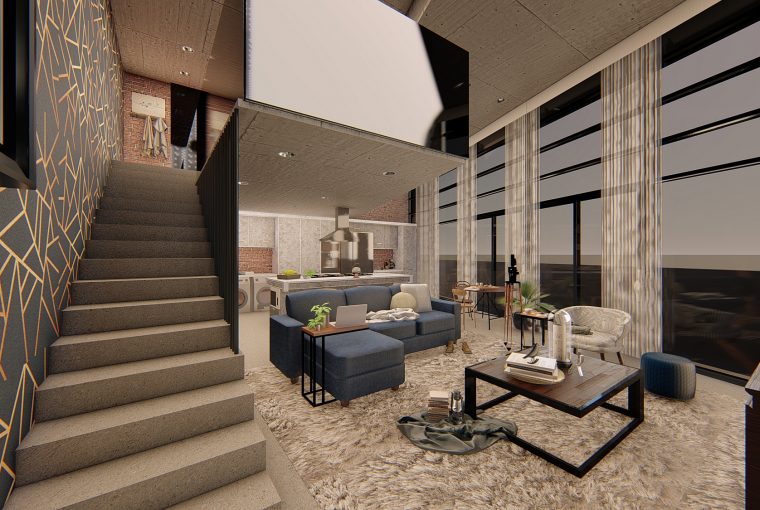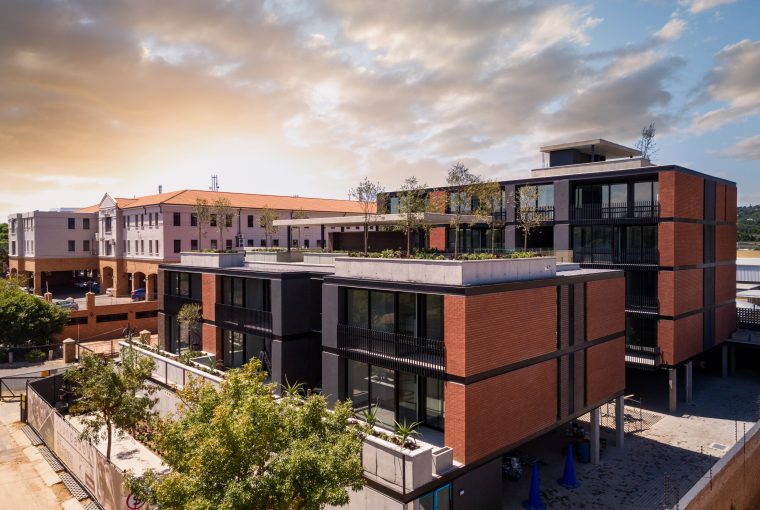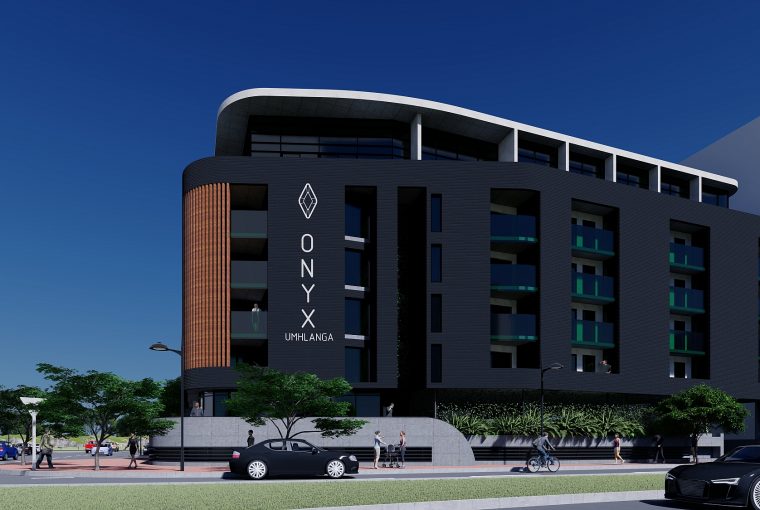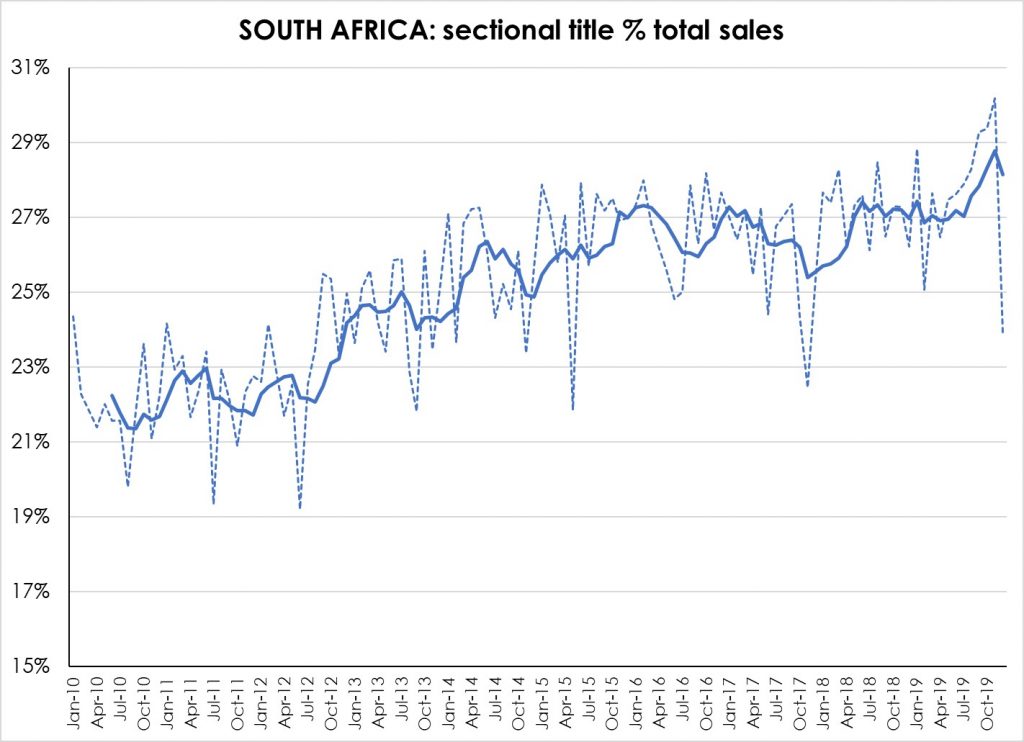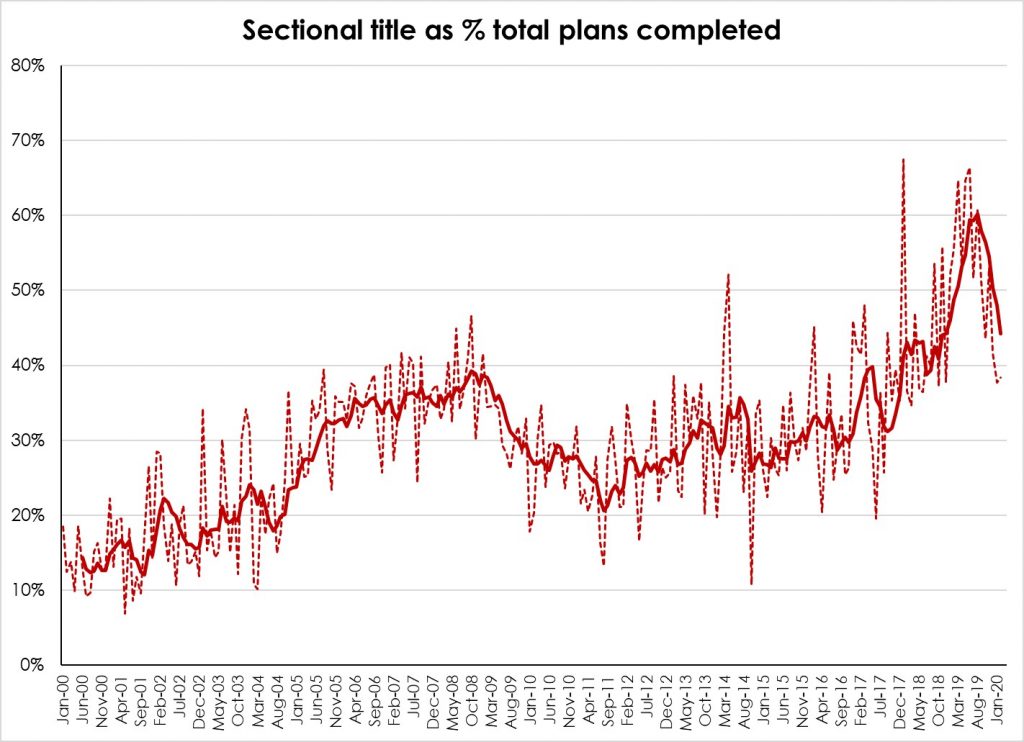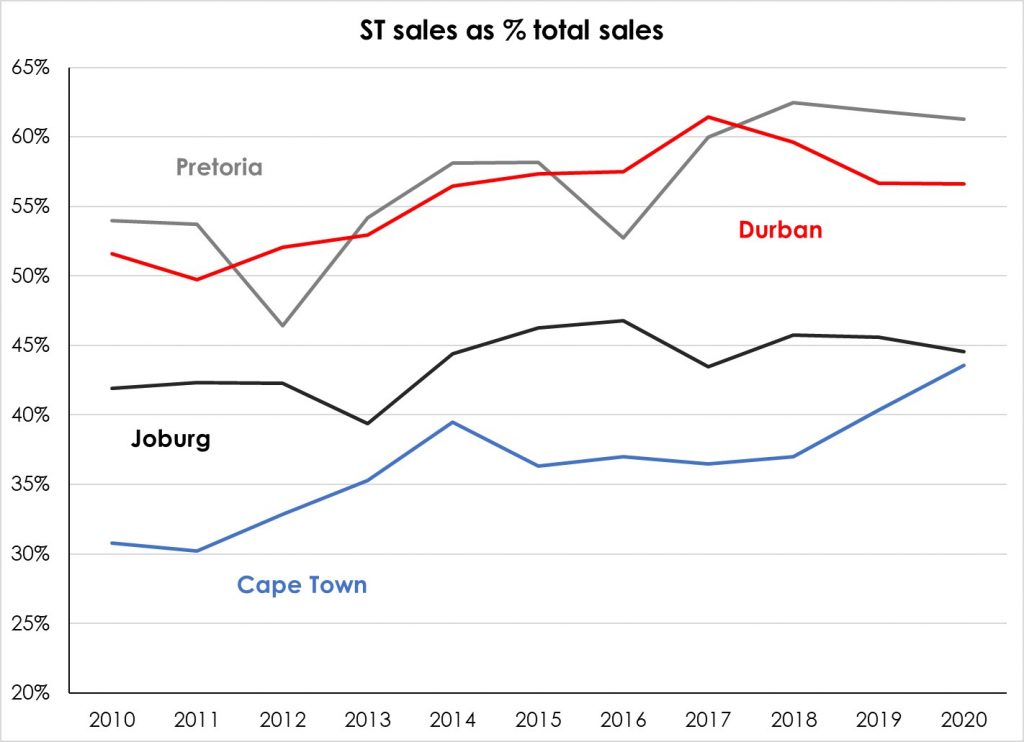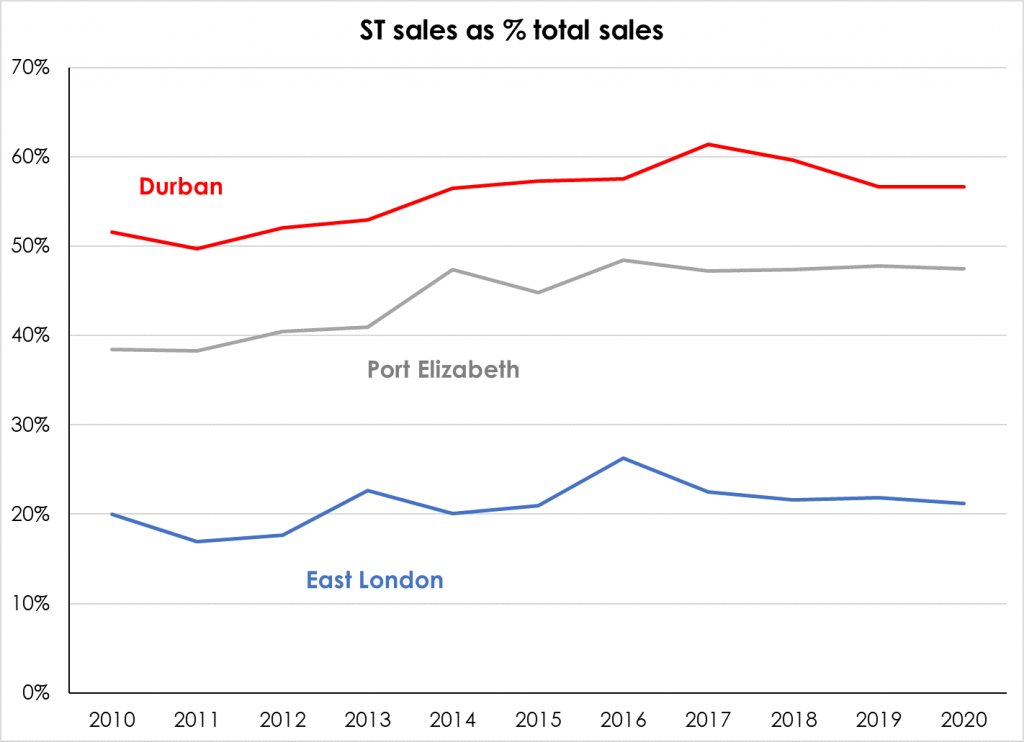While on the one hand the Covid-19 outbreak and subsequent lockdown has seen some heading for more spacious, freestanding homes with open spaces – including properties on estates, others, in contrast, still see the benefits of more compact, manageable accommodation in sectional title units, says Dr Andrew Golding, chief executive of the Pam Golding Property group.
“According to Lightstone data, sectional title units now account for a growing percentage of total sales nationally – rising from an average of 22% of all sales in 2010 to 27.7% of all sales in 2019. This is despite the large number of new, affordable, predominantly freehold homes which are being developed and sold in cities across South Africa which has been adding steadily to the national stock of freehold homes.”
SOURCE: Lightstone
As mortgage originator ooba points out, property investors need to stay abreast of trends in the property market, which can be affected by political and economic factors. The popularity of sectional title homes has grown over the past decade, not only because they tend to be more cost-effective, but also because they offer heightened security and a more communal way of life. Ooba notes that sectional title properties generally perform well in South Africa due to their popularity with students and first-time home buyers.
Says Dr Golding: “In 2000, 13.5% of all plans completed were for sectional title homes (the total includes homes under 80sqm, namely affordable homes). By 2019 this had risen to 54.9% (although this dropped to 46.1% in the first two months of 2020 – the latest data available). During the third quarter of 2019, sectional title as a percentage of total plans completed peaked at 59.7%.
SOURCE: Statistics SA
“Interestingly, Pretoria has the largest number of sectional title properties, while East London has the lowest. The median price of sectional title properties in Cape Town is significantly higher than in other metro markets – presumably because Johannesburg and Pretoria have higher numbers of first-time buyers purchasing sectional title homes relative to Cape Town.
| ST stock | Median price 2020 Rm | ST sales % total 2010 | ST sales % total 2019 | ST sales % total 2020 | |
| Johannesburg | 63 323 | 0.75 | 41.9 | 45.6 | 44.6 |
| Cape Town | 56 913 | 1.35 | 30.8 | 40.4 | 43.6 |
| Pretoria | 103 225 | 0.80 | 54.0 | 61.8 | 61.3 |
| Durban | 53 375 | 0.70 | 51.6 | 56.7 | 56.6 |
| East London | 5 296 | 0.65 | 20.0 | 21.9 | 21.2 |
| Port Elizabeth | 23 195 | 0.65 | 38.4 | 47.8 | 47.5 |
SOURCE: Lightstone
“Cape Town has also registered the strongest growth in market share for sectional title sales over the past decade, from 30.8% of all sales in 2010 to 43.6% in 2020, reflecting an increase of 12.8%.
SOURCE: Lightstone
SOURCE: Lightstone
“Port Elizabeth has also seen a growing percentage of sectional title sales – 38.4% in 2010 rising to 47.5% in 2020, which is an increase of 9.1%. However, in East London, sectional title sales remain largely unchanged at just over 21% of total unit sales.”
Whether the size of sectional title units is likely to increase, as a result of residents being locked down in smaller units, remains to be seen, says Sandra Gordon, Pam Golding Properties senior research analyst.
“The impact of the lockdown on changes in the size of sectional title properties presumably will be driven by the length of the lockdown and whether or not there are further risks anticipated from global pandemics, coupled with affordability factors, given that the economy is likely to remain in the doldrums for some time.
“There is likely to always be a demand for affordable units, particularly in Johannesburg and to an extent Pretoria, as young people tend to flock to Gauteng looking for employment and first-time buyers typically show a preference for sectional title properties. The age profile of South Africa’s population, coupled with the lock-up-and-go lifestyle and rising maintenance and utility costs all favour sectional title properties.
“Historically we have seen the layout of homes change over time, with the decline of staff quarters, garages and swimming pools, as well as the separate study, but that could change in a post-Covid environment as people start working from home more often and hence need a dedicated working space, which could even be a nook or a spare bedroom.
“Already, if one looks at new developments, there is a tendency to include the kitchen in the living space as people cook less and order in more often. There seems to be a growing consensus that post Covid there will be a new hybrid model, with people returning to the office some of the time but still working from home a couple of days a week, which could increase the demand for a dedicated work area at home – if affordable.
“It also seems likely that in a lockdown/social distancing environment, common areas – to the extent that residents are allowed to use them – would be a hugely attractive offering for buyers, particularly in terms of outdoor space.”
Micro living with a macro lifestyle
Gareth Bailey, Pam Golding Properties area principal for Durban Coastal, challenges the mindset of ‘bigger is better’, saying that for a variety of reasons, people are questioning the pros and cons of ‘living large’ with some even considering the polar opposite – less is more. He asks: Could micro living become a way of life?
“The definition of micro living is geographically dependent, but on our KwaZulu-Natal North Coast, it means living in a sectional title property ranging in size from about 15-30sqm and priced between R500 000 and R1 million. The target market is millennial creatives and professionals ranging from 20 to 35 years of age.
“The fundamental idea of micro living is trading the luxury of space, usually found in the suburbs, for significantly smaller space in the trendy heart of the metro where all the action can be found and where real estate prices are usually high.
“By buying a smaller space, the absolute ticket price is more affordable and, if the development is designed properly, this doesn’t come at a lifestyle cost as its facilities match and often exceed those found in a lavish suburban home – albeit these are shared between the resident community.”
Bailey says by being in the heart of the action, micro-dwellers in these sectional title units enjoy walking access to the metro’s top-rated attractions, entertainment options and amenities. The central location usually also provides walking access to the workplace and key transport hubs.
Says Bailey: “This way of living begs the question of whether owning a car is even necessary. If the development provides an Uber collect-and-drop facility, shuttle service or car pool arrangement, these millennials may well choose to disown the inconvenient rigidity of monthly car instalments, fuel and maintenance and rather opt for the ultimate freedom and flexibility of a pay-as-you-go solution. After all, the end goal of micro-living is to have ultimate flexibility and maximum lifestyle with minimum admin.
“Another upside is the sense of community and lifestyle – post-Covid – as residents engage with other like-minded people in activities such as gym, yoga, Pilates, or even catching up over a cup or glass of the latest brew all within the boundaries of the scheme.
“The living space itself requires innovative design to facilitate space saving and an example of this is having a fold-up bed that doubles as a dining room table, or which may even be raised above the living area altogether to free up space in the apartment.
“The micro living sectional title proposition may also make good financial sense as it allows buyers to get onto the property ladder by acquiring apartments in fantastic areas that would usually be financially out of reach. In addition, when the time comes to move on, the purchaser may choose to rent out the property at a high yield or re-leverage and buy a second property, thereby facilitating the growth of a property portfolio.”
Bailey says the micro living model dismisses the traditional notion of valuing property purely on a price-per-square-metre basis and rather requires investors to fully appreciate the value proposition of the development and the lifestyle – centrality, convenience, facilities and community – that it has to offer.
“Fortunately, renters have long shed the umbilical attachment to the price-per-square-metre valuation method, opting rather to value property based on the above appealing benefits. Consider holidaymakers, for example, who would far rather have centrality and access to the main attractions over a larger apartment further away from the action. Holidaymakers are seeking a hassle-free, good time, and they don’t differ too much from micro-dwellers in this respect.
“This departure from square-metre-based pricing means that while a micro living apartment may be expensive when judged by traditional methods, as long as the development is designed to satisfy the needs of its target market, tenants will find value and be prepared to pay in excess of traditional square metre rates. For this reason, micro living apartments have been known to achieve rental yields far beyond those of traditional long-term rental properties and many sophisticated investors have woken to this opportunity.
“Some people may feel that that micro living is claustrophobic, while others may really connect with this minimalist approach to living that simultaneously maximises flexibility, lifestyle and sense of community. I don’t think this is for everyone, but I definitely think that it is going to appeal to an increasing number of millennials seeking to do things on their own terms.”
For further information contact Pam Golding Properties via headoffice@pamgolding.co.za or gareth.bailey@pamgolding.co.za.
Posted by The Know - Pam Golding Properties


